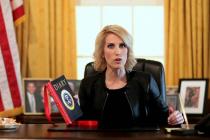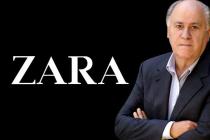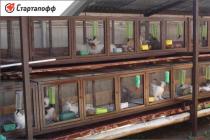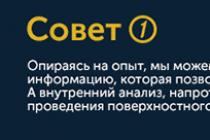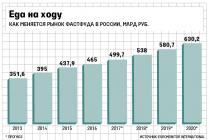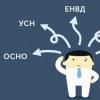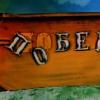The average annual cost of fixed assets is an indicator that characterizes the average cost of a company's fixed assets. It also allows you to evaluate how effectively the company uses own resources. In the article, methods of calculation and scope of the indicator.
What are fixed assets
Fixed assets are property owned by an enterprise on a long-term basis, and which are used in the activities of the company.
Fixed assets are both industrial and non-productive purposes. For example, spinning machines in a weaving factory belong to the funds for production purposes, they are a means of labor and take part in the manufacture of fabric. As for fixed assets for non-production purposes, they include, for example, sanatoriums, educational establishments, residential buildings - in other words, property transferred to the jurisdiction of non-profit structures.
Download and get to work:
The formula for calculating the average annual cost of fixed assets, taking into account the time of their write-off and commissioning
The basic formula for calculating the average annual OPF cost easy to use, but has a significant drawback. Since it does not take into account the moment of commissioning of fixed assets and the moment of their decommissioning, it cannot be applied in a situation in which it is fundamental high accuracy calculations.
For such a case, a different formula is more suitable, taking into account the dynamics of the receipt and disposal of fixed assets.
Wed. = Sn.g. + M1 /1 2 * Cin. - M2 / 12 * Sel.
where Cng is the cost of OPF at the beginning of the year,
With input. – cost of fixed assets put into operation during the year,
From choice - the value of assets written off during the year,
M1 - time during which the introduced OF were used (in months)
M2 - the time during which the written-off fixed assets were not used. (in months)
Example 2
Let's take the initial data of example 1 as a basis and calculate the average annual cost of fixed assets, taking into account their input (write-off):
Avg \u003d 20,000 + (8 / 12 * 300 + 5 / 12 * 200 + 3 / 12 * 400) - (10 / 12 * 100 + 11 / 12 * 500) \u003d 19841.67 thousand rubles.
Note that this method calculation is more time-consuming, but at the same time more accurate - since it allows you to take into account the uneven operation of funds. The average annual cost of fixed assets calculated in this way is also called the average annual total book value of fixed assets.
Calculation of the average annual cost of OPF according to the balance sheet
The average annual cost of the OPF can also be determined using the balance sheet indicators as a basis.
The formula used for this calculation will look like:
Wed. \u003d Sat + (Svved. * M) / 12 - (Svyb. * (12 - Mf)) / 12
where Sat is the book value of fixed assets,
Cvved. - the cost of the OPF, commissioned funds,
Cvyb. - the cost of decommissioned fixed assets,
M is the time that has elapsed since the start of using the OPF (in months),
Mf - the time during which the fixed assets were used before its retirement (in months).
Residual (book) value of all OPF organizations, is indicated on line 150 of the balance sheet.
Determination of the average annual cost of the OPF according to the average chronological
If the goal of the calculations is maximum accuracy, it is advisable to apply the chronological average method. First, determine the average cost of the OPF for each month (including input and write-off), and then divide the sum of these values by 12.
Cav = ((From 01.01 + From 31.01) / 2 + (From 01.02 + From 28.02) / 2 ... + (From 01.12 + From 31.12) / 2) / 12
where C as of 01.01 is the cost of the OPF at the beginning of the first month of the year;
From 31.01 - the cost of the OPF at the end of the first month, and so on.
Example 4
Let's determine the average annual cost of OPF according to the data from the first example
C on 01.01 = C on 31.01 = C on 01.02 = C on 28.02 = C on 01.03 = C on 31.03 31 = C on 01.04 = 20000
C on 30.04 = 20000+300= 203000= C on 01.05 = C on 31.05 = C on 01.06 = C on 30.06 = C on 01.07
From 31.07 = 20300 + 200 = 20500 = From 01.08 = From 31.08 = From 01.09
From 30.09 = 20500 + 400 = 20900 = From 01.10
From 31.10 = 20900 - 100 = 20800 = From 01.11
From 30.11 = 20800 - 500 = 20300 = From 01.12 = From 31.12
C \u003d ((20000 + 20000) / 2 + (20000 + 20000) / 2 + (20000 + 20000) / 2 + (20000 + 20300) / 2 + (20300 + 20300) / 2 + (20300 + 20300) / 2 + (20300 + 20500) / 2 + (20500 + 20500) / 2 + (20500 + 20900) / 2 + (20900 + 20800) / 2 + (20800 + 20300) / 2 + (20300 + 20300) / 2) / 12 = 20337.5 thousand rubles
The method that uses the chronological average is the most accurate, but at the same time the most labor-intensive algorithm for calculating the average annual cost of the OPF.
Calculation of the average annual cost of OF according to the rules of the Tax Code
The Tax Code of the Russian Federation establishes a special algorithm for calculating the average annual cost of fixed assets, which taxpayers are required to use when calculating corporate property tax.
Avg= (Status on 01.01+ Status on 01.02 + ... + Status on 01.12 + Status on 31.12) / 13
Example 5
Table 1. Residual value of fixed assets of the enterprise (thousand rubles)
|
OPF cost |
Calculate the average annual cost of OF:
(400 + 380 + 360 + 340 + 320 + 300 + 280 + 260 + 240 + 220 + 200 +180 + 160): (12 months + 1) = 280 thousand rubles.
Using the average annual cost of OPF in economic analysis
Let's consider the scope of application of the average annual cost of OPF in the calculation of other economic indicators.
If we take the volume of products manufactured by the enterprise and divide it by the average annual cost of the OPF, then we get return on assets ratio, which actually shows , how many manufactured products in monetary terms account for 1 ruble of fixed assets.
If, over time, the return on assets of the enterprise increases, this allows us to conclude that the company's capacities are used efficiently. Decrease in return on assets - on the contrary, says the opposite.
If the average annual cost of the OPF is taken as a dividend, and the volume of output is used as a divisor, then the capital intensity ratio will be obtained, which allows you to determine what value of fixed assets is needed to manufacture a unit of output.
If we divide the average annual cost of the OPF by average headcount workers, this will allow us to calculate the capital-labor ratio, which shows the extent to which each of the employees of the enterprise is provided with the necessary means of labor.
If the average annual cost of the OPF is multiplied by the depreciation rate coefficient characterizing the operating conditions of the funds, we will get the amount of depreciation deductions for the year. This indicator can be used not only as a retrospective, but also in the preparation of business plans, as a forecast.
The cost of the OPF is usually carried over to finished goods over a fairly long period. In some cases, it may cover several cycles. In this regard, the organization of accounting is carried out in such a way that it is possible to simultaneously reflect both the preservation of the original form and the loss of price over time. In this case, as key indicator used average annual cost of OPF. In the article, we will consider how it is determined and what indicators are used in this case.
general characteristics
Means (structures, buildings, equipment, etc.), as well as objects of labor (fuel, raw materials, and so on) participate in the output of products. Together they form production assets. A certain group partially or completely retains its natural-material form over many cycles. Their cost is transferred to finished products as they wear out in the form of depreciation. The specified group is formed by production. They are directly involved in the production of goods. Non-production funds ensure the formation of social infrastructure.
Classification
The main production assets include:
- Buildings are objects of architecture designed to create working conditions. These include garages, workshop buildings, warehouses, etc.
- Structures - objects of engineering and construction type used for the implementation of the transportation process. This group includes tunnels, bridges, track arrangements, water supply systems, and so on.
- Transmission devices - gas and oil pipelines, power lines, etc.
- Equipment and machines 0 presses, machine tools, generators, engines, etc.
- Measuring devices.
- computers and other equipment.
- Transport - locomotives, cars, cranes, loaders, etc.
- Tools and inventory.

Key quantities
The cost of the OPF can be replacement, residual and initial. The latter reflects the costs of obtaining fixed assets. This value is unchanged. The initial cost of funds that come from the capital investments of certain companies can be established by adding up all the costs. These include, among other things, the cost of transportation, the price of equipment and installation, etc. The replacement cost is the cost of purchasing fixed assets in the current conditions. To determine it, revaluation of funds is carried out using indexation or the direct recalculation method based on current market prices, documented. equal to the recovery, reduced by the amount of wear. There are also private indicators of OS usage. These include, in particular, the coefficients of intensive, integral, extensive operation of equipment and shifts.

Loss of original properties
Average annual cost of OPF determined taking into account depreciation and amortization. This is due to the fact that with prolonged use of funds in technological process they quickly lose their original properties. The degree of wear can be different - it depends on various factors. These, in particular, include the level of operation of funds, the qualifications of personnel, the aggressiveness of the environment, etc. These factors affect different indicators. So, to determine the return on assets, an equation is first compiled, according to which the average annual cost of the OPF is established (formula). The capital-labor ratio and profitability depend on the revenue and the number of employees.
Obsolescence
It means the depreciation of funds even before the physical loss of properties. can appear in two forms. The first is due to the fact that the production process reduces the cost of funds in the areas in which they are produced. This phenomenon does not lead to losses, as it acts as a result of an increase in savings. The second form of obsolescence arises as a result of the appearance of such OPF, which are distinguished by high productivity. Another indicator that is taken into account is depreciation (the process of transferring the cost of funds to manufactured products). It is necessary for the formation of a special monetary reserve for the complete renovation of facilities.

Average annual cost of OPF: formula for calculating the balance sheet
To determine the indicator, it is necessary to use the data that are present in They should cover transactions not only as a whole for the period, but also separately for each month. How is determined average annual cost of OPF? Balance Formula the following is used:
X = R + (A × M) / 12 - / 12, where:
- R - initial cost;
- A - st-st introduced funds;
- M - the number of months of operation of the introduced BPF;
- D - the value of the liquidation value;
- L is the number of months of operation of retired funds.
OS put into operation
As can be seen from the above information, the equation by which is determined average annual cost of OPF (formula), includes indicators that require separate analysis. First of all, the initial price of the funds is set. To do this, take the amount of the balance at the beginning of the reporting period according to the account. 01 balance sheet. After that, it should be analyzed whether any OS were put into operation during the period. If it was, you need to set a specific month. To do this, you should look at the revolutions in dB ch. 01 and set the value of the funds put into action. After that, the number of months in which these operating systems were operated is calculated and multiplied by the cost. Next is determined average annual cost of OPF. Formula allows you to set the value of the funds put into use. To do this, the indicator obtained by multiplying the number of months of use by the original price of the OS is divided by 12.

Average annual cost of OPF: formula for calculating the balance sheet (example)
Let's say the OS at the beginning of the period was 3670 thousand rubles. During the year, funds were introduced:
- on March 1 - 70 thousand rubles;
- on the 1st of August - 120 thousand rubles.
Also taken into account is the disposal of:
- on February 1st - 10 thousand rubles;
- on June 1st - 80 thousand rubles.
- X \u003d 3670 + (120 × 5: 12 + 70 × 10: 12) - (80 × 6: 12 + 10 × 11: 12);
- X \u003d 3670 + (50.0 + 58.3) - (40.0 + 9.2) \u003d 3729.1 thousand rubles.
Retirement
In the analysis, in addition to the funds put into operation, written-off funds are determined. It is necessary to establish in which month they dropped out. For this, the turnovers are analyzed according to Kd sch. 01. After that, the cost of retired funds is determined. When writing off fixed assets during the entire reporting period, the number of months in which they were operated is established. Next, you need to determine the average annual cost of retired funds. To do this, their price is multiplied by the difference between the total number of months in the entire reporting period and the number of months of operation. The resulting value is divided by 12. The result is the average annual value of the OPF that left the enterprise.

Final operations
At the end of the analysis, the total average annual cost of the FTF is determined. To do this, you need to add up their initial cost at the beginning of the reporting period and the indicator for the funds put into operation. From the obtained value, the average annual cost of fixed assets that have retired from the enterprise is subtracted. In general, the calculations do not differ in complexity and laboriousness. When calculating the main task consists in the correct analysis of the statement. Accordingly, it must be compiled without errors.
In recent years, due to the steady growth in the range of products and the pace of its renewal, the nature industrial enterprises has changed. Enterprise management has become impossible without effective planning of its activities and control over the implementation of plans. Satisfying the needs of consumers required the acceleration of the organization of the release of new products, i.e. flexible development of enterprises. The elements of flexible development of the enterprise should also include the process of manufacturing competitive products in conditions of limited financial opportunities using all available resources.
In market conditions, when developing new areas of activity, the ideology of budgeting as an element of strategic control becomes the main instrument of corporate governance.
Formation of the company's budget - the basics financial management and economic regulator of relations between its structural divisions And external environment- is one of the main factors for ensuring competitiveness.
The means of production at the disposal of factories are divided into means of labor (buildings, machines, machine tools) and objects of labor (materials, semi-finished products, fuel, locomotives and wagons).
The means of production form production assets, which are divided into fixed and circulating.
Fixed production assets (OPF) are means of labor that fully or partially retain their natural-material form for many years. production cycles(usually years) and transfer their value to finished products in parts, as they wear out.
results modern production are increasingly determined by the renewal and improvement of production assets and depend on the degree of their use.
Fixed assets by composition, purpose, performed in manufacturing process functions are usually divided into the following groups that characterize their structure: buildings, structures, transmission devices, machinery and equipment, vehicles, tools, industrial and household inventory.
According to the role in the production process, the active and passive parts of fixed assets are distinguished.
Active fixed assets are tools of labor that directly affect output, i.e. involved in the transformation of objects of labor into finished products. These are machines and equipment installed in the main workshops of enterprises, adjustable instruments and devices, tools.
Passive fixed assets are those that ensure the normal functioning of the active part of the funds. These are buildings, roads, power plants, supplying working machines with electricity, transmission devices delivering this energy, vehicles.
The initial cost of fixed assets is expressed in the prices of their acquisition or commissioning. At these prices, fixed assets are taken into account in the balance sheet of the enterprise and depreciation is charged. The initial cost of equipment included in fixed assets consists of the purchase price, transport costs for delivery and costs for construction and installation works (construction of the foundation, installation and debugging).
Replacement cost is the cost of reproduction of fixed assets. It takes into account the same costs as the original cost, but in modern conditions, and allows you to compare the volume of fixed assets by enterprises. For these purposes, an inventory and revaluation of fixed assets is periodically carried out.
The full (original and replacement) cost is the cost of fixed assets in a new, unworn condition. At full cost, the funds are accounted for on the balance sheet of the plant during the entire period of their operation.
The residual value is calculated as the difference between the full original cost and the amount of depreciation. It expresses that part of the value of fixed assets that has not yet been transferred to the cost of products manufactured with their help, and is determined by the formula:
F srg = F ng + (F cc* p) / 12 - F select * (12 - p) / 12, ( 1.1)
where F srg - average annual cost of fixed assets;
F ng - initial (book) cost of fixed assets;
F centuries - the cost of fixed assets introduced;
n - the number of months of operation of the commissioned / retired fixed assets;
F sb - liquidation value;
The return on assets is determined by the ratio of the volume of output to the value of fixed production assets, calculated by the formula:
F otd = V vp / F srg , ( 1.2)
where F otd - capital productivity;
V vp - volume of output;
F srg - average annual cost of fixed assets.
Capital intensity - is an inverse indicator of capital productivity and shows the number of fixed assets required for the production of products per 1 ruble. Determined by the formula:
F capacity = F srg /V vp , (1.3)
where F capacity - capital intensity.
The capital-labor ratio shows the share of fixed production assets per worker, that is, it characterizes the level of security production staff means of production. Calculated according to the formula:
F voor = F srg / h cn , (1.4)
where F voor - capital-labor ratio;
H cn - payroll personnel.
Profitability of sales - an indicator of the financial performance of the organization, showing what part of the organization's revenue is profit. In this case, various profit indicators can be used as a financial result in the calculation. Determined by the formula:
R=P/S*100%, (1.5)
where R - profitability of sales;
P - profit from sales;
C - cost.
Calculations of the average annual cost of fixed assets are made according to the balance sheet. In turn, this indicator serves as the basis for calculating the performance indicators for the use of fixed assets and studying the dynamics of changes in their value.
In the system of indicators for assessing the movement of fixed assets, the characteristic of the intensity of their renewal is also important.
To do this, calculate the coefficient of renewal of fixed assets for a certain period:
TO update = F input / F con. G , . ( 1.6)
where K o6n - update factor;
F input - the cost of newly introduced (arrived) fixed assets for a certain period;
F con. G. - the value of fixed assets at the end of the year (period) for which the fixed assets are analyzed.
The process of updating fixed assets involves studying the nature of their disposal. The assessment of this process is carried out according to the retirement rate of fixed assets for a certain period:
TO select = F select / F early , ( 1.7)
where K you6 - retirement rate;
F select - the cost of retiring fixed assets for a certain period;
F early - the value of fixed assets at the beginning of the same period.
The processes of renewal and disposal of fixed assets should be mutually evaluated. To do this, study the growth rate of fixed assets:
TO nature = (F input - F select ) /F ng , ( 1.8)
where K nature - coefficient of growth of fixed assets;
F ng - the value of fixed assets at the beginning of the period.
Fixed production assets (OPF) are the means of production of long-term use: buildings, structures, machinery and equipment, etc.
To calculate depreciation charges and performance indicators for the use of fixed production assets, their average annual cost is calculated.
We calculate the average annual cost for each type using formulas depending on the initial data.
For transmission devices, it is planned to dispose of 17,900 thousand rubles. in the 1st quarter, the average annual cost of the OPF is planned according to the formula
where F is the average annual cost of the OPF, thousand rubles;
F 1.01 -- cost of OPF at the beginning of the year, thousand rubles;
FN.S.G. -- the cost of OPF at the beginning of the next year, thousand rubles;
F 1.02, ..., F 1.12 - the cost of the OPF at the beginning of each month, thousand rubles.
For machinery and equipment, it is planned to put into operation 84,300 thousand rubles. from June 1, the average annual cost of OPF can be calculated using the formula
where F BB -- the cost of the OPF put into operation, thousand rubles;
F SELECT - the cost of out-of-service fixed assets, thousand rubles;
t 1 - the number of full months remaining until the end of the year from the moment the BPF is put into operation;
t 2 -- the number of full months remaining until the end of the year from the date of retirement
OPF out of service.
For vehicles, it is planned to decommission 2,800 thousand rubles. in August, the average annual cost of OPF can be calculated using the formula 5
enterprise revenue costs profitability
Since the input time is 1620 thousand rubles. for computer technology is not planned, then the average annual cost of the OPF can be calculated by the formula
F NG + S F BB - S F SEL,
where F NG - the cost of the OPF at the beginning of the year, thousand rubles;
F BB -- the cost of commissioned fixed assets, thousand rubles;
F SELECT - the cost of out-of-service fixed assets, thousand rubles.
5300 + = 6110 thousand rubles
We calculate the structure for each type of BPF using the example of machines and equipment:
where - the average annual cost of the OPF for the element, thousand rubles;
The total average annual cost of the OPF, thousand rubles.
The calculation results are summarized in Table 2.
Table 2 -- Average annual cost and structure of the OPF
According to this RUES, the active part includes machinery and equipment, transmission devices, Computer Engineering, tools and vehicles, and account for 63.8% of the total cost of OPF. The passive part of the OPF includes buildings, and makes up 36.2% of the total cost of the OPF. In general, for this RUES, the structure of the BPF is rational
Average annual cost of fixed assets- this is the average value of the indicator of the availability of fixed assets during the year.
Average annual cost of fixed assets formula
Average annual cost of fixed assets = (Value of fixed assets at the beginning of the year + Cost of fixed assets at the end of the year) / 2
Was the page helpful?
More found about the average annual cost of fixed assets
- Influence of labor intensity on capital intensity. Production and return on assets, capital-labor ratio The purchase of new machine tools on the economic situation of the enterprise was generally positively reflected in the increase in the item of the average annual cost of fixed assets by 2.5 million rubles
- Methodology for express analysis of the performance of a commercial organization Considering the above, to calculate the average annual cost of fixed assets, the authors recommend using the following formula
- Average annual cost of fixed production assets Average annual cost of fixed production assets The average annual cost of fixed production assets is the sum of the value of fixed production assets at the beginning and
- The methodology of industry trend analysis in assessing the financial and economic activities of a FT enterprise - capital-labor ratio of labor is defined as the ratio of the average annual cost of fixed assets of fixed assets to the number of industrial and production personnel N 5. Labor productivity index where
- Impact of costs on the level of financial results of agricultural enterprises in the Kursk region Year Growth rate % Growth rate % 2009 2010 2011 2012 2013
- Initial cost of fixed assets Further fixed assets Average annual cost of fixed assets Sources of fixed assets Fixed capital Depreciation of fixed assets Depreciation of fixed assets
- The method of sectoral trend analysis in identifying possible reserves for increasing the efficiency of the organization's economic activities. As initial data, information is used on the volume of production, the cost of products manufactured, the average annual cost of fixed assets, the number of industrial and production personnel. Using the methodology presented above, we will search for reserves to increase
- Production assets Non-production assets Average annual value of fixed assets Sources of fixed assets Fixed capital Depreciation of fixed assets Depreciation of fixed assets
- Analysis of the organization's business activity, taking into account taxation The ratio of gross net marketable output to the average annual value of fixed assets Shows how much production or profit the organization receives from each ruble
- Active part of fixed assets Analysis in the block Analysis of the state of fixed assets and their reproduction depreciation of fixed assets average annual cost of fixed assets sources of fixed assets fixed capital depreciation of fixed assets depreciation of fixed assets
- Profitability: in order to manage, it should be measured correctly Many propose to define profitability as the ratio of profit to the average annual cost of fixed assets and material working capital 1 4 9 In fact, they
- Fixed assets of the enterprise Next Average annual cost of fixed assets Sources of fixed assets Fixed capital Depreciation of fixed assets Depreciation of fixed assets
- The methodology for managing the financial results of an enterprise R is the ratio of balance sheet profit to the sum of the average annual cost of fixed assets of fixed capital and working capital of fixed capital general profitability profitability of an enterprise is determined by
- Working capital and the efficiency of its use in the activities of LLC "Eletrosvyazstroy" In 2016, the amount of capital productivity in the organization decreased compared to 2014 by 7434.83 rubles or by 99.67%, which indicates a declining growth rate of revenue compared to the growth rate of the average annual cost of fixed production assets of the enterprise Annual labor productivity in 2016 compared to
- Return on non-current capital Return on non-current capital - a ratio equal to the ratio of book profit to the sum of the average annual book value of fixed production assets Calculation data - balance sheet Return on non-working capital ... Analysis and evaluation of profitability and profitability as return on investment Return on non-working capital - what shows Return on non-working capital shows the amount of profit attributable to ... Return on non-working capital shows the amount of profit attributable to a unit cost of fixed production means enterprises Return on non-working capital - formula General formula calculation of the Krvk coefficient
- Profitability of fixed assets return on investment fixed assets - a ratio equal to the ratio of balance sheet profit to the sum of the average annual balance sheet value of fixed production assets Calculation data - balance sheet return on investment fixed assets return on investment fixed assets shows the amount of profit per unit cost of fixed assets of the enterprise return on investment fixed assets - formula General formula for calculating the Kfos coefficient
- Return on non-current assets Return on non-current assets - a ratio equal to the ratio of balance sheet profit to the sum of the average annual balance sheet value of fixed production assets Calculation data - balance sheet Return on non-current assets ... Analysis and evaluation of profitability and profitability as return on investment Profitability of non-current assets - what shows Profitability of non-current assets shows the amount of profit attributable to ... Profitability of non-current assets shows the amount of profit per unit cost of fixed assets of the enterprise Profitability of non-current assets - formula The general formula for calculating the Krva coefficient
- return on investment return on investment- coefficient equal to the ratio of balance sheet profit to the sum of the average annual balance sheet value of fixed production assets. Data for calculation - balance sheet return on investment calculated in return on investment shows the amount of profit per unit cost of fixed assets of the enterprise return on investment- formula The general formula for calculating the coefficient Kf Profit before
- Analysis and evaluation of the effectiveness of the financial policy of the OS organization thousand rubles 39564.5 40675 42747 1110.5 2072 Average annual cost of the active part of fixed assets thousand rubles 23446 24498 26593.5 1052 2095.5
- Problems of analysis of fixed assets of the enterprise N S Fo 4 where S - the average annual cost of fixed assets Fo - capital productivity Thus, the increase in sales due to expansion

